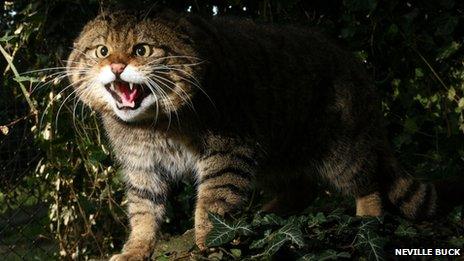Scottish wildcat extinct within months, association says
- Published

Scottish wildcats were thought to number about 400
Scottish wildcats will be extinct in the wild within months as numbers of pure-bred cats have fallen to about 35 individuals, conservationists warn.
A team put together by the Scottish Wildcat Association (SWA) reviewed 2,000 records of camera trap sightings, eyewitness reports and also road kills.
SWA said the analysis suggested there could be 35 wildcats - far fewer than previously thought.
Other research has estimated that there could be less than 400 pure-bred cats.
Last month, a report on a project funded by Scottish Natural Heritage (SNH) estimated that there were 150 breeding pairs left.
Disease and inter-breeding with domestic and feral cats are among the main threats to numbers of pure-bred wildcats.
SWA said licensed trapping of the mammals should be allowed so blood samples could be taken in an effort to better understand the state of the population.
It has also suggested relocating pure wildcats to areas where there are fewer risks, and it said it was working with the University of Oxford on an investigation of wildcats in Caithness and Sutherland.
Of the 2,000 records of hybrids and wildcats looked at by the SWA team less than 20 were deemed to comply with the accepted coat-marking identifiers of the true wildcat.
With an estimated 3,500 hybrids in Scotland the SWA said this would mean there were just 35 wildcats remaining.
SWA chairman Steve Piper said: "However you juggle the figures it's hard to find anything positive.
"If you ignore the eyewitness sightings because they're unreliable the numbers get even worse.
"Even if you decide the population of hybrids is larger you have to multiply it to impossible levels to get to the commonly quoted figure of 400 wildcats.
"The overwhelming evidence is that the wildcat is going to be extinct within months, anything else is blind hope."
According to SNH, external, estimates of wildcat numbers in Scotland have varied between 1,000 and 4,000. However, the agency said fewer than 400 cats with classical wildcat pelage were thought to survive.
In a report published last month on the SNH-funded Cairngorms Wildcat Project, it was estimated that 150 breeding pairs of wildcats survived in parts of the Highlands.
The document said wildcats were "very rare" and present in low numbers in the western half of the Cairngorms National Park - Badenoch and Strathspey, Highland Perthshire and possibly Glenlivet.
No records that could be substantiated with photographs or carcases were obtained from the eastern side of the park - Deeside, Donside and the Angus Glens.
The report also said the risks from hybridisation appeared to be "real and continuing".
'Parlous state'
Mr Piper said SWA and Oxford were sending people to Caithness and Sutherland, which he said was the one large area that had not been looked at in any real detail.
He said: "If we find wildcats, it raises new issues, they will be hard to protect in an expanse like Sutherland, realistically we need to relocate them somewhere they can be protected or put a truly vast amount of money and resources into the region to keep wildcats separated from hybrids and ferals."
SNH said the Scottish wildcat was a priority species and its new Wildcat Action Plan would seek to bring together all those interested in their conservation.
A spokesman said: "We agree that the evidence points to wildcat populations being in a parlous state.
"However, we need to be careful when drawing conclusions from sub samples and unverified records.
"The limited survey information available on this cryptic species provides an uncertain basis from which to state precisely how many animals may be living in the wild. This is something the action plan might seek to address."
- Published31 August 2012
- Published29 August 2012
- Published24 April 2012
- Published24 April 2012
- Published10 January 2012
- Published25 August 2011
- Published14 October 2010